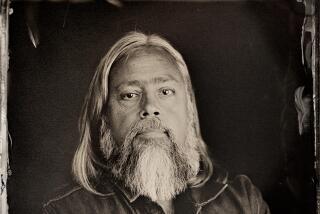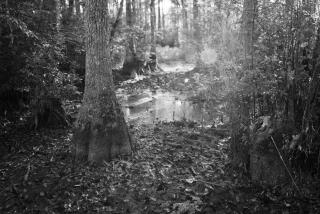Book review: ‘The Killing of Crazy Horse’ by Thomas Powers
The Killing of Crazy Horse
Thomas Powers
Alfred A. Knopf: 568 pp., $30
This we know to be true: Crazy Horse, legendary war leader of the Oglala Lakota Sioux, died in September 1877, at Camp Robinson, a U.S. Army fort in Nebraska. Some sources report that Crazy Horse was fatally wounded by a military guard while resisting arrest. Others describe his death as a murder by the U.S. government. How exactly did Crazy Horse die, and what does his death tell us about official U.S. government intentions toward the great American tribes at the end of the 19th century? These are the questions that Thomas Powers sets out to answer in “The Killing of Crazy Horse.”
History and story, myth and legend, primary and secondary sources form a thicket around Crazy Horse’s death. He was certainly a threat to the U.S. Army. For 20 of his approximately 33 years, he fought U.S. government efforts to encroach on native land, particularly in the gold-rich Black Hills of South Dakota. He was a significant leader in the Battle of the Little Bighorn in 1876 and has been credited by many with the Native American victory in that engagement and the death of Gen. George Armstrong Custer. This was only one of the many battles in Crazy Horse’s life: Stories of his bravery, told in other tribes and reported in various newspapers, took on a mystical, legendary quality even in his lifetime. These stories have grown even more vivid with time — for many, Crazy Horse has been the human embodiment of the last stand in the Native American way of life. Treaties came and went, but Crazy Horse represented something different: Native American power.
A Pulitzer Prize-winning journalist, Powers has written about the antiwar movement, intelligence organizations and the history of nuclear weapons. In his books and in his reporting for the Atlantic, the New York Review of Books, the New York Times and other publications (including this newspaper), he has earned his credibility the hard way: by sticking to the facts.
In the case of Crazy Horse, however, the facts are elusive. No one is even really sure of Crazy Horse’s date of birth, and the ambiguity carries through to his death. Powers is determined to untie the knots, to find out how Crazy Horse really died and why. There is a sustained feeling of excitement throughout the book, a sense of the historian’s hunt as Powers ferrets out the answers. At most junctures, there is more than one telling of events: Words that mean one thing in English mean something else in Sioux. In every newspaper report, the career and bias of the reporter are considered as well as the surge of public opinion at the time. With every firsthand report, Powers reveals the bias of the teller — his relationship to Crazy Horse, his investment in the myth of the man.
Powers relies heavily on eyewitness accounts, particularly those of William Garnett, a half-Sioux interpreter who was present at many events throughout the life of Crazy Horse, including his death. Powers admires Garnett’s “frank and thoughtful tone,” his willingness to spend a lifetime turning the story over in his mind, his withholding of judgment. And while Powers, who admits to being an active member of the last generation of American children to play cowboys and Indians (he’s proud to have played on the Indian side), strikes the same measured tone throughout this book, in the end it’s clear that he’s on the Indian’s side here as well.
Powers’ book portrays Crazy Horse in various states of mind: blind with rage after the death of a friend or relative, calm and full of clarity after days of meditation before a battle, showing defiance and courage in front of white soldiers. On more than one occasion, Crazy Horse, with sweetgrass in his hair and his face painted with white spots, rides back and forth well within shooting range and does not get hit.. “Crazy Horse rode to war protected and strengthened by magic, secret knowledge, the power of some animal guardians, in favor of gods and spirits. Many stories survive of the ways in which he used sacred power. It is evident he believed they kept him from harm and helped him defeat his enemies.… When he came onto the battlefield, his friends said, everybody felt stronger.” On the day he was killed, we learn, he did not prepare for battle, did not paint or arm himself in any way.
The death of Crazy Horse seems a hollow, pointless betrayal, premeditated by U.S. officials. Although many accounts recorded by soldiers claim that Crazy Horse backed into the bayonet of a soldier ushering him toward the jailhouse, there can be no doubt after Powers’ telling that he was murdered and that the murder was planned.
Gen. George Crook, Gen. Philip Sheridan, Black Elk, John Bourke, Red Cloud, Sitting Bull, Crazy Horse’s good friend He Dog, interpreter Frank Grouard, Lt. Jesse Lee (who brought Crazy Horse to Camp Robinson on Sept. 5, 1877, and greatly regretted his role in the death) are just a few of the characters whose stories Powers mines. He reconstructs the fateful scene at Camp Robinson with the same panoramic eye for detail that he focuses upon the Battle of the Little Bighorn.
In an afterword, Powers writes that he was driven by the “urgency of the story” and by the “richness of the evidentiary record.” He writes that he is grateful for the firm foundation of primary sources. But Powers has also clearly inhabited this story, living in it as one does a home or a piece of clothing that holds meaning for the wearer.
Salter Reynolds is a Los Angeles writer.
More to Read
Sign up for our Book Club newsletter
Get the latest news, events and more from the Los Angeles Times Book Club, and help us get L.A. reading and talking.
You may occasionally receive promotional content from the Los Angeles Times.








